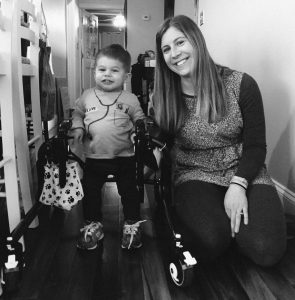A Journey of Teamwork
Physical therapists have certain expectations for themselves, and from others. We specialize in the human body, including restoring it, managing or preventing conditions, and achieving the patient’s best physical condition given the person’s current state. So what happens when a patient is referred to us with a rare neuroimmune disorder that we have never heard of before? Families are scared, and are looking to us for answers. So how do we treat these patients with conditions that are of the “unknown?”
Patients continue to teach medical professionals on a daily basis. I thought I would share one particular experience that has profoundly improved me as a clinician. Please note that not every patient responds to therapy in the same manner, so the recovery process varies for each individual. What has worked in this case may be different for others given the presentation and severity of the diagnosis.
I have had the pleasure of working with a family, whose 7-month-old son was referred to me after a diagnosis of Acute Flaccid Myelitis (or AFM). According to the CDC, “from August 2014 to July 2015, CDC has verified reports of 120 children in 34 states who developed acute flaccid myelitis.” With roughly 319 million people in the United States, that is .000038% of the population. Like most patients, I initially thought that I should be able to tell the family what to expect and exactly what to do. However, since this is such a rare condition that is still being researched, I quickly realized that is not what I am here to do. We are all in this learning process together.
The first thing all medical professionals should do when coming across a diagnosis that they have never treated before is to educate themselves. Thus, I did my research to find out what AFM was and how to go about treating it. Unfortunately, there is no treatment protocol, per se, and the long-term prognosis is unknown. No one is able to directly state whether or not these children will be able to walk again.
So, what next?
TREAT WHAT YOU KNOW
Although these rare diagnoses can be daunting, it is important to remember to treat what you know. The diagnosis may be new, but the impairments that come along with it are often impairments that we have seen before, and know how to treat. Breaking down the diagnosis into structural and functional impairments will guide the treatment plan.
KNOW YOUR LIMITS
Along with treating what you know, it is just as important to know your limits and ask for help or other opinions when necessary. Even if we are “pretty sure” we are doing all that we can do, it is best to get others opinions just in case there is something out there that we are not aware of. This is especially true with cases of rare neuroimmune disorders that we do not see everyday. Asking co-workers, recommending consults with other disciplines, and really taking into consideration the input of others will help guide the plan of care. In this manner, we can expand our current knowledge, share ideas, and best treat our patients.
GO AT THE FAMILY’S PACE
The patient and family are always our number one priority. We need to be very cognizant of their emotional state throughout this process. Imagine a child who has met all of his motor milestones now all of a sudden loses all mobility from the waist down. This experience is incredibly traumatic and overwhelming. Once home from the hospital and medically cleared, we step in to start outpatient services. The family is scared, and therapy is their hope. There are many things to discuss, and a long road ahead. However, it is important not to overwhelm them during this sensitive time; meet them where they are emotionally, and go at the family’s pace. Take the time to physically show them every small improvement that is observed; this can help them emotionally cope with their feelings of loss.
BE AN ADVOCATE
After researching AFM, I learned that intense physical therapy is the best treatment, after the acute treatments of steroids, intravenous immunoglobulin (IVIg), or plasmapheresis. Each medical treatment will vary depending on the individual. Starting therapy services as early as a child is medically cleared to do so, will help to prevent atrophy and bone loss that can be seen with any paralysis. It is our job to advocate for these patients who do not fall within the normal protocols of therapy, and strive for multiple therapy sessions per week. Advocate for these intense services, including getting other disciplines involved. Or, recommend activities such as swimming, gymnastics, horseback riding, music therapy, and dance classes. I am fortunate to be working for an early intervention program, which gives children access to many different services. I know this is not the case everywhere, and that is why supplemental activities are important. Any appropriate activity that challenges the body in different ways can be an option. Think outside the box in the treatment plan. After all, these children are 1 in 2.7 million — they are unique and their therapy services should be as well.
EMPOWER THE FAMILY
In addition to advocating for services, it is important to realize that we will not always be there with the family. Therefore, we need to empower the family to advocate on their own, and teach them how to do so. Giving them the tools to advocate and know how to manage their child’s care is important, and it will make all the difference. The patient and family will be managing the child’s care on a daily basis, and we need to make sure they are comfortable doing so. It is important to organize the child’s environment to promote therapeutic play throughout the day. A child will do whatever it takes to get to what he or she wants, which allows us to promote challenges in the natural environment. For example, if you are working on standing activities, help the family arrange their household environment so that all of the child’s toys are up high (on a table, easel, play kitchen, etc.). This makes therapeutic play more natural.
The child I see participates in seven structured therapy services per week, as well as therapeutic play throughout his day with his family. This can be overwhelming for families, so guiding them on how to manage their time is beneficial. Designate one person to organize the team, and develop a specific plan for therapeutic play or exercises, including what to prioritize. This can relieve a lot of the stress for families wondering where to start on their long list of activities.
With all of these services, the child is now 2 years old and walking with a posterior gait trainer. He has been receiving services now for over 1.5 years and continues to show progress on a weekly basis. Patients may hit plateaus, so trying a different approach can be what is needed. That is not to say all cases should have these exact services or will see the same progress; as I have stated before, every patient’s road to recovery is different. However, advocating to give them the best possible chance is essential. The neurological system is an incredible and beautiful system that has the ability to regenerate for years to come with continued hard work. It is never too late to start.
While thinking about writing this post, the one word that continues to pop up into my head is “teamwork.” It is remarkable to watch so many people come together to support one patient on their journey with a rare neuroimmune disorder. Each individual is just as invested as the next. I will never forget looking around at an appointment with over 10 medical professionals watching this now 2-year-old walk down the hallway. All of us were so proud of how far he has come, and hopeful of where he is going. We are regularly in contact with each other and discuss our ideas, questions, and concerns. The family’s perspective and priorities are always of utmost importance. The families we serve are strong, and continue to unify us as a medical team. This is what makes a success story. I truly attribute the outstanding progress with this “unknown” diagnosis to the fact that every single person is working together in harmony to do whatever is necessary for this child to continue to grow and thrive as he deserves.
So, treating a patient with a rare neuroimmune disorder is not really scary. It’s something that we are all prepared to do if we take a step back, slow down, and work together to complete the puzzle. It is a beautiful journey of hope, perseverance, teamwork, dedication, and love.
Jenna Elie, PT, DPT
Northeast Arc Early Intervention
Want to become a part of the team? We invite you to join our “Send a Kid to Camp” fundraiser. It’s the perfect way to support our cause and help a family get to our 2017 Annual Family Camp. Join us now! Your support really does help change lives!





